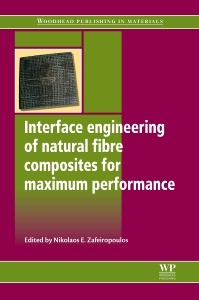Description
Interface Engineering of Natural Fibre Composites for Maximum Performance
Woodhead Publishing Series in Composites Science and Engineering Series
Coordinator: Zafeiropoulos Nikolaos E
Language: English
Subjects for Interface Engineering of Natural Fibre Composites for...:
Support: Print on demand
Description
/li>Contents
/li>Biography
/li>Comment
/li>
Part one focuses on processing and surface treatments to engineer the interface in natural fibre composites and looks in detail at modifying cellulose fibre surfaces in the manufacture of natural fibre composites, interface tuning through matrix modification and preparation of cellulose nanocomposites. It also looks at the characterisation of fibre surface treatments by infrared and raman spectroscopy and the effects of processing and surface treatment on the interfacial adhesion and mechanical properties of natural fibre composites. Testing interfacial properties in natural fibre composites is the topic of part two which discusses the electrochemical characterisation of the interfacial properties of natural fibres, assesses the mechanical and thermochemical properties and moisture uptake behaviour of natural fibres and studies the fatigue and delamination of natural fibre composites before finishing with a look at Raman spectroscopy and x-ray scattering for assessing the interface in natural fibre composites
With its distinguished editor and international team of contributors Interface engineering of natural fibre composites for maximum performance is an invaluable resource to composite manufacturers and developers, materials scientists and engineers and anyone involved in designing and formulating composites or in industries that use natural fibre composites.
Contributor contact details
Part I: Processing and surface treatments to compose the interface in natural fibre composites
Chapter 1: Modifying cellulose fiber surfaces in the manufacture of natural fiber composites
Abstract:
1.1 Introduction
1.2 Physical treatments
1.3 Chemical grafting
1.4 Conclusions
Chapter 2: Interface engineering through matrix modification in natural fibre composites
Abstract:
2.1 Introduction
2.2 Motivation behind using natural fibre composites and trends
2.3 Challenges in using natural fibre composites: the problem of low adhesion
2.4 Matrix modification, coupling mechanism and efficiency of bonding
2.5 Effect of matrix modification on interfacial properties
2.6 Effect of matrix modification on macroscopic properties
2.7 Future trends
2.8 Sources of further information and advice
Chapter 3: Preparation of cellulose nanocomposites
Abstract:
3.1 Introduction
3.2 Hierarchical structure of natural fibers
3.3 From micro- to nanoscale
3.4 Preparation of cellulose nanocrystals
3.5 Processing of cellulose nanocomposites
3.6 Properties of cellulose nanocomposites
3.7 Conclusions and future trends
Chapter 4: Characterization of fiber surface treatments in natural fiber composites by infrared and Raman spectroscopy
Abstract:
4.1 Introduction
4.2 Methods and techniques
4.3 Analysis of natural fibers and surface treatments
4.4 Chemical treatments
4.5 Interfaces in polymer composites
4.6 Summary
Chapter 5: Testing the effect of processing and surface treatment on the interfacial adhesion of single fibres in natural fibre composites
Abstract:
5.1 Introduction
5.2 Methods for characterization of single-fibre–polymer matrix interfacial adhesion
5.3 Review of lignocellulosic polymer fibre–matrix interfacial adhesion data
5.4 Conclusions
Chapter 6: Assessing fibre surface treatment to improve the mechanical properties of natural fibre composites
Abstract:
6.1 Mechanical testing of fibres
6.2 Statistical treatment of single-fibre strength
6.3 Mechanical properties of untreated single fibres
6.4 Influence of fibre treatment on mechanical properties of natural fibres
6.5 Conclusion
6.6 Acknowledgements
Part II: Testing interfacial properties in natural fibre composites
Chapter 7: Electrokinetic characterisation of interfacial properties of natural fibres
Abstract:
7.1 Introduction
7.2 Streaming potential measurements
7.3 Electrokinetic properties of natural fibres
7.4 Conclusion
Chapter 8: Mechanical assessment of natural fiber composites
Abstract:
8.1 Introduction
8.2 Materials and experimental procedures
8.3 Mechanical testing
8.4 Conclusions
Chapter 9: Thermomechanical and spectroscopic characterization of natural fibre composites
Abstract:
9.1 Introduction
9.2 Natural fibre composites
9.3 Interfaces in natural fibre composites and their characterization
9.4 Microscopic techniques
9.5 Spectroscopic techniques
9.6 Thermomechanical methods
9.7 Conclusions
Chapter 10: Assessing the moisture uptake behavior of natural fibres
Abstract:
10.1 Introduction
10.2 Methods of quantifying moisture uptake of natural fibres
10.3 Moisture uptake behaviour of various natural fibres
10.4 Summary
10.5 Acknowledgements
Chapter 11: Creep and fatigue of natural fibre composites
Abstract:
11.1 Introduction
11.2 Fundamentals of the creep test
11.3 Life prediction of natural fibre composites using long-term creep analysis
11.4 Creep modelling
11.5 Nonlinear viscoelastic response
11.6 Stress relaxation
11.7 Fatigue
11.8 Factors affecting the fatigue life of natural fibre composites
11.9 Wood-based composites
11.10 Conclusions
11.11 Acknowledgements
11.12 Notation
Chapter 12: Impact behavior of natural fiber composite laminates
Abstract:
12.1 Introduction
12.2 Phenomenon description
12.3 Testing methods and instruments
12.4 Interpretation of the experimental data
12.5 Nondestructive inspection (NDI) ultrasonic techniques
12.6 Acknowledgements
Chapter 13: Raman spectroscopy and x-ray scattering for assessing the interface in natural fibre composites
Abstract:
13.1 Introduction to Raman spectroscopy
13.2 Raman spectroscopy and measurements of molecular deformation in polymer fibres
13.3 X-ray diffraction and stress analysis in fibres and composites
13.4 Raman spectroscopy and x-ray diffraction measurements of molecular and crystal deformation in cellulose fibres
13.5 Discussion
13.6 Conclusions
Index
- Examines characterisation of fibre surface treatments by infrared and raman spectroscopy and the effects of processing and surface treatment
- Reviews testing interfacial properties in natural fibre composites including the electrochemical characterisation of the interfacial properties of natural fibres
- Assesses the mechanical and thermochemical properties and moisture uptake behaviour of natural fibres and studies the fatigue and delamination of natural fibre composites




